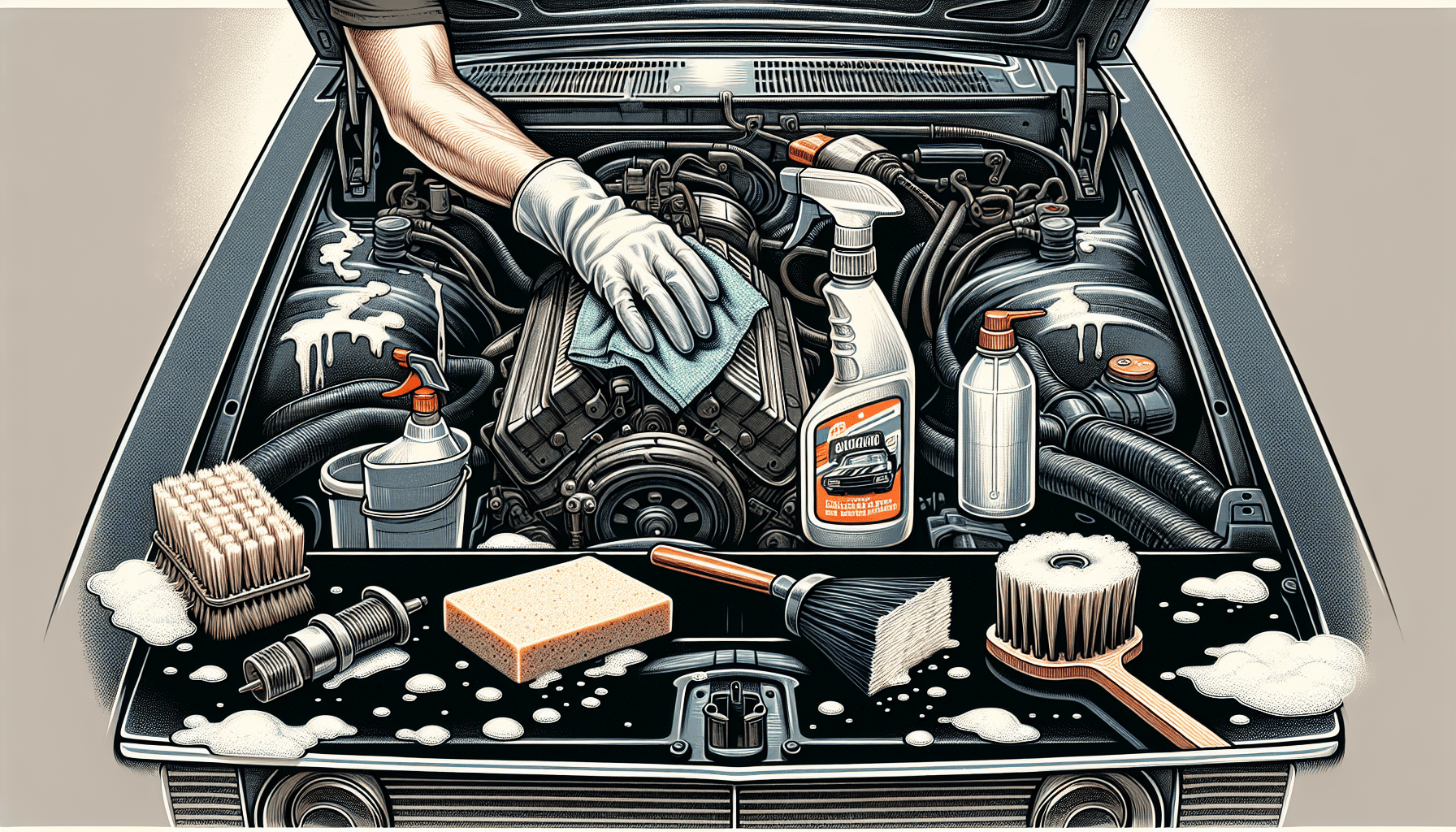Ace Mobile
Detailing

Top 7 Tips For Engine Bay Cleaning
Looking to give your engine bay a sparkling clean? Look no further because Ace Mobile Detailing has got you covered! Based in Orange Beach, AL, we are a fully licensed and insured professional detailing shop that specializes in automotive, boat, RV, and aircraft detailing, as well as ceramic coatings. With our top-notch products and expert service, we are here to help you enhance the appearance of your vehicle or boat. Our number one goal is to leave our clients feeling amazing when they hit the road or water. And today, we’re excited to share with you our top seven tips for giving your engine bay the cleaning it deserves. So let’s roll up our sleeves and get that engine bay looking spotless!

1. Safety Precautions
When it comes to cleaning your engine bay, safety should always be your top priority. Before you begin, there are a few precautions you should take to ensure a safe and efficient cleaning process.
Disconnect the battery: Before you start working on your engine, it’s essential to disconnect the battery. This will help prevent any accidental electrical shock or damage to your vehicle’s electrical system.
Cover sensitive components: To protect sensitive components from water or cleaning products, it’s a good idea to cover them with plastic bags or plastic wrap. This will prevent any potential damage and ensure that your engine remains in proper working condition.
Avoid using excessive water: While it’s necessary to clean the engine bay, excessive water can cause damage to sensitive electrical components. Instead, opt for targeted cleaning methods and avoid spraying water directly onto electrical connectors, sensors, and other sensitive areas.
Wear protective gear: Cleaning your engine bay can be a dirty and potentially hazardous task. It’s important to wear protective gear, such as gloves and safety goggles, to protect yourself from any chemicals, debris, or potential injuries.
2. Gather Essential Tools and Supplies
Before you get started with cleaning your engine bay, it’s essential to gather all the necessary tools and supplies. Having the right equipment will make the cleaning process much more efficient and effective.
Some essential tools and supplies you will need include:
Plastic bags: These will be useful for covering sensitive components and preventing any water or cleaning products from getting on them.
Degreaser: A good quality degreaser will help break down the grease and grime that has accumulated on your engine.
Brushes: Different types of brushes, such as a soft-bristle brush and a detailing brush, will be needed to agitate dirt and debris.
Microfiber towels: These towels are great for wiping down surfaces and absorbing excess moisture.
Plastic wrap: If you don’t have plastic bags, plastic wrap can also be used to cover sensitive components.
Engine shine or dressing: After cleaning, you may choose to apply an engine shine or dressing to give your engine bay a professional and polished look.
Air compressor or leaf blower: An air compressor or leaf blower can be used to remove debris and dry hard-to-reach areas.
Having these tools and supplies ready will ensure that you have everything you need for a thorough and effective cleaning.
3. Prepare the Engine Bay
Before diving into the cleaning process, it’s important to properly prepare your engine bay. This will help ensure that you can clean every nook and cranny effectively.
Cool down the engine: It’s important to let your engine cool down completely before you start cleaning. Working on a hot engine can be dangerous and may lead to burns.
Remove loose debris: Take a moment to remove any visible loose debris, such as leaves, twigs, or dirt. Use a brush or your hand to gently sweep away this debris.
Apply degreaser: Once your engine bay is clear of loose debris, apply a degreaser to the surfaces. This will help break down the built-up grease and grime, making it easier to clean.
Cover sensitive areas: Before you start spraying water or using any cleaning products, make sure to cover sensitive areas with plastic bags or wrap. This will protect them from any potential damage.
Taking the time to properly prepare your engine bay will ensure that you can clean it thoroughly and safely.
4. Clean the Engine Surface
Now that your engine bay is prepped, it’s time to start cleaning the engine surface. This is where you’ll get rid of the dirt, grease, and grime that has accumulated over time.
Use a brush to agitate dirt: Start by using a soft-bristle brush or a detailing brush to agitate the dirt and grime on the engine surface. Scrub gently but firmly to loosen any built-up dirt.
Rinse with water or pressure washer: After agitating the dirt, rinse the engine surface with water or a pressure washer. Be careful not to use excessive pressure, as it can damage sensitive components. Aim for a gentle stream of water to wash away the dirt.
Apply degreaser if necessary: If there are stubborn grease stains or heavy grime buildup, you can apply a degreaser directly to those areas. Let it sit for a few minutes to break down the grease, and then rinse it off with water.
Wipe down with microfiber towels: Once you’ve rinsed off the cleaning products, use microfiber towels to wipe down the engine surface. This will help remove any remaining dirt or excess moisture.

5. Clean Hard-to-Reach Areas
Cleaning hard-to-reach areas in your engine bay can be a challenge, but it’s an essential step to ensure a thorough cleaning. Here are some tips to help you tackle those tricky spots:
Use brushes or cotton swabs: Use smaller brushes or cotton swabs to clean tight spaces and crevices. This will allow you to agitate dirt and remove debris from areas that are difficult to reach with larger brushes.
Be gentle to avoid damage: When cleaning hard-to-reach areas, it’s important to be gentle to avoid damaging any components. Take your time and use a light touch to ensure you don’t accidentally break or dislodge anything.
Use compressed air to remove debris: If you have an air compressor or a leaf blower, you can use it to blow out any debris from hard-to-reach areas. This will help remove dust, dirt, and other particles that may have accumulated.
Taking the time to clean those hard-to-reach areas will ensure that your engine bay is thoroughly cleaned from top to bottom.
6. Dry and Protect the Engine Bay
After cleaning your engine bay, it’s important to properly dry and protect it. This will not only give it a polished look but also help prevent any potential damage or corrosion.
Use microfiber towels to dry: Once you have finished cleaning, use microfiber towels to dry the engine bay. These towels are highly absorbent and will help remove any remaining moisture.
Remove covers from sensitive components: After drying, carefully remove the plastic covers or wraps from sensitive components, making sure not to damage anything in the process. This will allow the engine bay to dry completely.
Apply engine shine or dressing: If desired, you can apply an engine shine or dressing to give your engine bay a clean and polished appearance. Follow the manufacturer’s instructions for application.
Protect electrical connections: Finally, take a moment to check and protect any electrical connections in your engine bay. Make sure they are secure and free from any moisture. You can apply dielectric grease to protect them from corrosion.
Properly drying and protecting your engine bay will help ensure that it remains clean and in good condition for a longer period of time.
7. Maintain Regular Cleaning Schedule
Now that you have a clean engine bay, it’s important to maintain it regularly to keep it in top condition. Here are a few tips for maintaining a regular cleaning schedule:
Clean engine bay every few months: Depending on your driving conditions and the amount of dirt and grime that accumulates, it’s recommended to clean your engine bay every few months. This will help prevent buildup and keep your engine running smoothly.
Check for leaks or damage: While cleaning your engine bay, take the time to inspect for any signs of leaks or damage. Address any issues promptly to avoid further damage to your vehicle.
Keep engine bay free from debris: After cleaning, make an effort to keep your engine bay free from debris. Regularly check for leaves, twigs, and other debris that may have accumulated and remove them promptly.
Regularly inspect belts and hoses: As you clean, take a moment to inspect the belts and hoses in your engine bay. Look for any signs of wear or damage and address them as needed. Regular maintenance is key to a well-functioning engine.
By following these tips and maintaining a regular cleaning schedule, you can ensure that your engine bay remains clean, organized, and in excellent condition.
In conclusion, cleaning your engine bay is an important part of vehicle maintenance. By following these top 7 tips, you can keep your engine running smoothly and enhance the overall appearance of your vehicle. Remember to always prioritize safety, gather the necessary tools and supplies, properly prepare the engine bay, clean the surface and hard-to-reach areas, dry and protect the engine bay, and maintain a regular cleaning schedule. With these steps in mind, you’ll have a clean and well-maintained engine bay that will make you feel proud every time you pop the hood.

